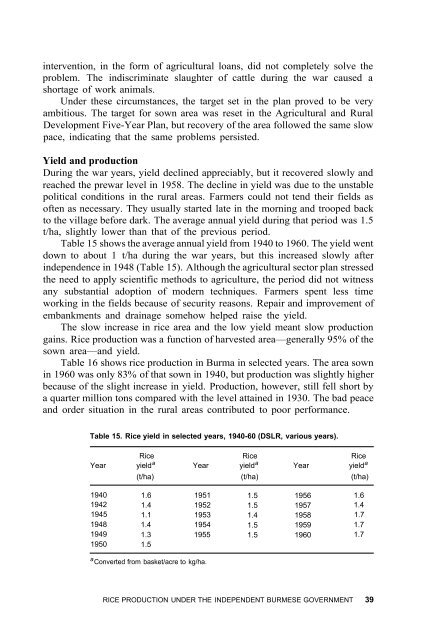A century of rice improvement in Burma - IRRI books - International ...
A century of rice improvement in Burma - IRRI books - International ...
A century of rice improvement in Burma - IRRI books - International ...
- No tags were found...
You also want an ePaper? Increase the reach of your titles
YUMPU automatically turns print PDFs into web optimized ePapers that Google loves.
<strong>in</strong>tervention, <strong>in</strong> the form <strong>of</strong> agricultural loans, did not completely solve theproblem. The <strong>in</strong>discrim<strong>in</strong>ate slaughter <strong>of</strong> cattle dur<strong>in</strong>g the war caused ashortage <strong>of</strong> work animals.Under these circumstances, the target set <strong>in</strong> the plan proved to be veryambitious. The target for sown area was reset <strong>in</strong> the Agricultural and RuralDevelopment Five-Year Plan, but recovery <strong>of</strong> the area followed the same slowpace, <strong>in</strong>dicat<strong>in</strong>g that the same problems persisted.Yield and productionDur<strong>in</strong>g the war years, yield decl<strong>in</strong>ed appreciably, but it recovered slowly andreached the prewar level <strong>in</strong> 1958. The decl<strong>in</strong>e <strong>in</strong> yield was due to the unstablepolitical conditions <strong>in</strong> the rural areas. Farmers could not tend their fields as<strong>of</strong>ten as necessary. They usually started late <strong>in</strong> the morn<strong>in</strong>g and trooped backto the village before dark. The average annual yield dur<strong>in</strong>g that period was 1.5t/ha, slightly lower than that <strong>of</strong> the previous period.Table 15 shows the average annual yield from 1940 to 1960. The yield wentdown to about 1 t/ha dur<strong>in</strong>g the war years, but this <strong>in</strong>creased slowly after<strong>in</strong>dependence <strong>in</strong> 1948 (Table 15). Although the agricultural sector plan stressedthe need to apply scientific methods to agriculture, the period did not witnessany substantial adoption <strong>of</strong> modern techniques. Farmers spent less timework<strong>in</strong>g <strong>in</strong> the fields because <strong>of</strong> security reasons. Repair and <strong>improvement</strong> <strong>of</strong>embankments and dra<strong>in</strong>age somehow helped raise the yield.The slow <strong>in</strong>crease <strong>in</strong> <strong>rice</strong> area and the low yield meant slow productionga<strong>in</strong>s. Rice production was a function <strong>of</strong> harvested area—generally 95% <strong>of</strong> thesown area—and yield.Table 16 shows <strong>rice</strong> production <strong>in</strong> <strong>Burma</strong> <strong>in</strong> selected years. The area sown<strong>in</strong> 1960 was only 83% <strong>of</strong> that sown <strong>in</strong> 1940, but production was slightly higherbecause <strong>of</strong> the slight <strong>in</strong>crease <strong>in</strong> yield. Production, however, still fell short bya quarter million tons compared with the level atta<strong>in</strong>ed <strong>in</strong> 1930. The bad peaceand order situation <strong>in</strong> the rural areas contributed to poor performance.Table 15. Rice yield <strong>in</strong> selected years, 1940-60 (DSLR, various years).Rice Rice RiceYear yield a Year yield a Year yield a(t/ha) (t/ha) (t/ha)1940194219451948194919501.61.41.11.41.31.5195119521953195419551.51.51.41.51.5195619571958195919601.61.41.71.71.7a Converted from basket/acre to kg/ha.RICE PRODUCTION UNDER THE INDEPENDENT BURMESE GOVERNMENT 39

















